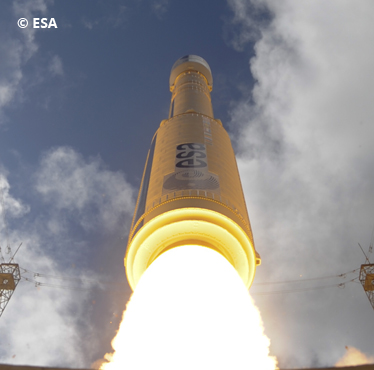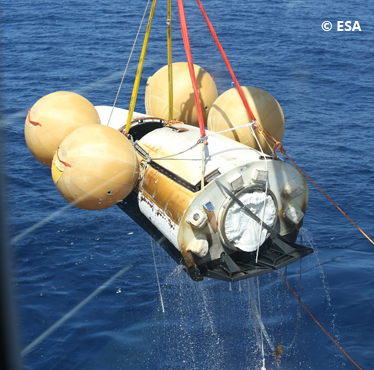Roma 11 February 2015
A 100 minutes flight for IXV (Intermediate eXperimental Vehicle), the technology demonstrator developed by the European Space Agency (ESA) to test the atmospheric reentry of a space vehicle. Finmeccanica takes part in the program with a primary role through its the companies active in the Space sector.
Launched on Febr uary 11 2015 on board of a Vega rocket from the Guiana Space Center in Kourou, the demonstrative mission ended with the parachute descent and then a splashdown in the Pacific Ocean, where the IXV was immediately recovered by a specially equipped ship.
uary 11 2015 on board of a Vega rocket from the Guiana Space Center in Kourou, the demonstrative mission ended with the parachute descent and then a splashdown in the Pacific Ocean, where the IXV was immediately recovered by a specially equipped ship.

At the ALTEC Mission Control Center in Turin, specialized technicians followed the mission in real time, coordinating the ground stations during IXV's flight and the naval recovery operations after splashdown.
IXV is a unique European space mission and it is the result of an extraordinary collaboration between European industries and scientific research centers
 Thales Alenia Space Italia was responsible for the entire project, for the development and integration of the vehicle, and heads a consortium comprising major European manufacturers, research centers and universities which also involved Telespazio, Selex ES and Alenia Aermacchi.
Thales Alenia Space Italia was responsible for the entire project, for the development and integration of the vehicle, and heads a consortium comprising major European manufacturers, research centers and universities which also involved Telespazio, Selex ES and Alenia Aermacchi.
Telespazio designed and developed the Ground Segment Network (GSN) in partnership with Altec and OHB. In addition, the company created the network that connects ALTEC's Mission Control Centre in Turin with the stations in Fucino, Kourou, Libreville, Malindi, the IXV capsule and the support ship. Telespazio contributes significantly to the VEGA program by building both the software of the command and control systems on the ground and the new flight software known as Flight Programme Software Alternatives (FPSA). In addition, Telespazio, through its subsidiary Telespazio France, supports the Vega launch services from the Kourou Space Centre.
Selex ES has been responsible for designing the demonstrator Power Distribution Unit, and Alenia Aermacchi has been responsible for the development of the avionic subsystem and software.
IXV offers excellent aerodynamic properties because of its fuselage shape, which maximizes lift and maneuverability. It is equipped with a high-performance guidance, navigation and control system that uses automatically controlled aerodynamic surfaces during the atmospheric reentry phase. Also, it is protected by a heat shield designed to bear the extremely high temperatures of an atmospheric reentry.
The mission is of particular importance since, for the first time, Europe has carried out an atmospheric reentry experiment with a spacecraft that has aerodynamic maneuver capabilities, a sort of automatic mini shuttle, and this is an essential step for the design of future applications in the field of space transportation and exploration of the solar system.
Thanks to the data collected during the flight, Europe can now look up to the develoment of new generation reentry vehicles, with the ambition to carry in the near future the Old Continent towards space autonomy.

